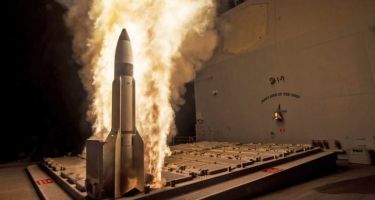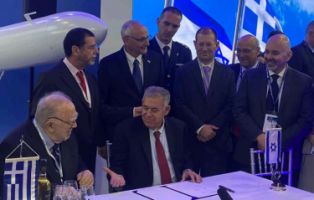Global $5.65 Bn Autonomous Military Aircraft Markets, 2015-2020, 2020-2025F, 2030F: Focus on Fighter Aircrafts, Bombers, Reconnaissance and Surveillance Aircrafts, Airborne Early Warning Aircrafts - ResearchAndMarkets.com
The "Autonomous Military Aircraft Global Market Report 2021: COVID-19 Growth and Change to 2030" report has been added to ResearchAndMarkets.com's offering.
The global autonomous military aircraft market is expected to grow from $4.06 billion in 2020 to $4.22 billion in 2021 at a compound annual growth rate (CAGR) of 3.9%.
Autonomous Military Aircraft Global Market Report 2021 provides the strategists, marketers and senior management with the critical information they need to assess the global autonomous military aircraft market.
The growth is mainly due to the companies resuming their operations and adapting to the new normal while recovering from the COVID-19 impact, which had earlier led to restrictive containment measures involving social distancing, remote working, and the closure of commercial activities that resulted in operational challenges. The market is expected to reach $5.65 billion in 2025 at a CAGR of 8%.
The autonomous military aircraft market consists of sales of autonomous military aircraft which are guided autonomously from the ground, designed to attack surface targets with bombs or missiles and to destroy enemy targets in warfare. They carry sensors, target designators, offensive ordnance, and electronic transmitters among others.
Increasing government funding on defense equipment such as autonomous military aircraft to enhance the efficiency in military operations boosts the demand for the market. For instance, in 2019, the UK government-funded $152.3 million (GBP 125 million) to support research on new technologies for autonomous aircraft. Hence, increasing government spending on autonomous military aircraft is a key factor for driving the market.
The major constraint of autonomous military aircraft is its vulnerability to jamming and spoofing. Securing GPS signals to ensure that they cannot be tampered by enemy forces acts as the inherent liability of GPS to jamming and spoofing and acts as a major challenge. In particular, communication links between the controller and the autonomous military aircraft are extremely vulnerable and the required target accuracy is difficult to achieve due to navigation errors. Due to this, the aircraft is misdirected and becomes either unusable or a threat to their personnel equipment.
The autonomous military aircraft market covered in this report is segmented by technology into remotely operated, semi-autonomous, autonomous and by type into fighter aircraft, bombers, reconnaissance and surveillance aircraft, airborne early warning aircraft, others.
Autonomous military aircraft companies are making efforts to embed artificial intelligence (AI) and specialize in the development of software, including machine learning and AI that are core capabilities for these advanced systems. The ability of a system to decide on the most suitable action from sensor data input to fulfill the intent for operations by making guesses without human input can be achieved by AI technology.
Through edge processing, aircraft do not have to send information to the cloud and thus may achieve greater performance, information security, and autonomy. U.S. Defense Advanced Research Projects Agency (DARPA) is seeking to advance artificial intelligence technologies for individual and team aerial dogfighting tactics.
In June 2019, Raytheon and United Technologies two of the world's largest aerospace and defense companies planned to merge, which would create a giant with products that range from Tomahawk missiles and radar systems to jet engines.
United Technologies, which makes electronics and engines for the commercial aviation sector, agreed to combine its business with Raytheon, missile systems and military equipment manufacturer. They also plan to combine research budgets and teams to explore futuristic technologies such as hyper sonics, directed energy weapons, and artificial intelligence.
Major players in the autonomous military aircraft market are Boeing, Lockheed Martin Corp, GE Aviation, Northrop Grumman, BAE Systems, Israel Aerospace Industries (IAI), Elbit Systems, Dassault Aviation S.A., Denel Dynamics and Airbus SE.
Key Topics Covered:
1. Executive Summary
2. Autonomous Military Aircraft Market Characteristics
3. Autonomous Military Aircraft Market Trends and Strategies
4. Impact of COVID-19 on Autonomous Military Aircraft
5. Autonomous Military Aircraft Market Size and Growth
5.1. Global Autonomous Military Aircraft Historic Market, 2015-2020, $ Billion
5.1.1. Drivers of the Market
5.1.2. Restraints on The Market
5.2. Global Autonomous Military Aircraft Forecast Market, 2020-2025F, 2030F, $ Billion
5.2.1. Drivers of the Market
5.2.2. Restraints on the Market
6. Autonomous Military Aircraft Market Segmentation
6.1. Global Autonomous Military Aircraft Market, Segmentation By Technology, Historic and Forecast, 2015-2020, 2020-2025F, 2030F, $ Billion
- Remotely Operated
- Semi-Autonomous
- Autonomous
6.2. Global Autonomous Military Aircraft Market, Segmentation By Type, Historic and Forecast, 2015-2020, 2020-2025F, 2030F, $ Billion
- Fighter Aircrafts
- Bombers
- Reconnaissance and Surveillance Aircrafts
- Airborne Early Warning Aircrafts
- Others
6.3. Global Autonomous Military Aircraft Market, Segmentation By Component, Historic and Forecast, 2015-2020, 2020-2025F, 2030F, $ Billion
- Flight Management Computers
- Air Data Intertial Refernece Units
- Sensors
- Actuation Systems
- Software
- Intelligent Servos
- Cameras
- Radars & Transponders
- Propulsion Systems
7. Autonomous Military Aircraft Market Regional and Country Analysis
7.1. Global Autonomous Military Aircraft Market, Split By Region, Historic and Forecast, 2015-2020, 2020-2025F, 2030F, $ Billion
7.2. Global Autonomous Military Aircraft Market, Split By Country, Historic and Forecast, 2015-2020, 2020-2025F, 2030F, $ Billion
Companies Mentioned
- Boeing
- Lockheed Martin Corp
- GE Aviation
- Northrop Grumman
- BAE Systems,
- Israel Aerospace Industries (IAI)
- Elbit Systems
- Dassault Aviation S.A.
- Denel Dynamics
- Airbus SE
- United Technologies Corporation
- General Dynamics Corporation
- Raytheon Company
- Safran SA
- Rolls Royce
- China Aerospace Science and Technology Corporation
- Kratos Defence & Security Solutions Inc.
- Textron Inc.
For more information about this report visit https://www.researchandmarkets.com/r/g0tmj4
View source version on businesswire.com: https://www.businesswire.com/news/home/20210811005486/en/






